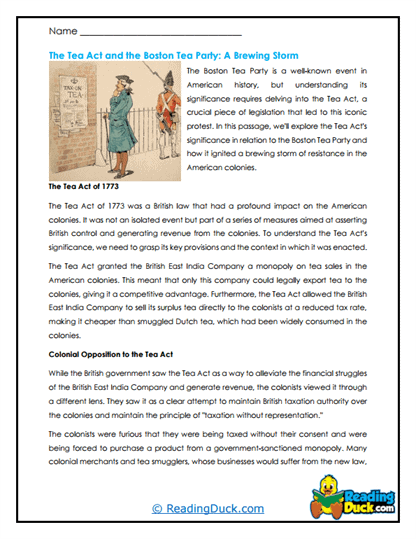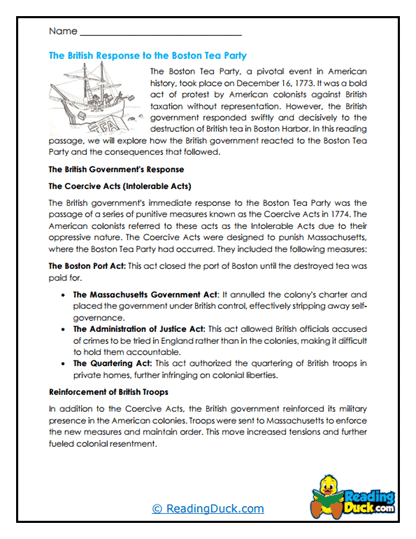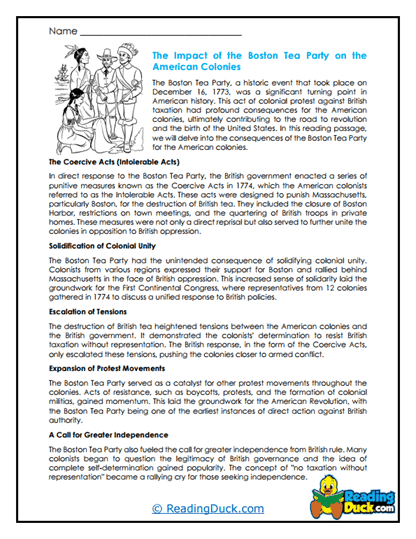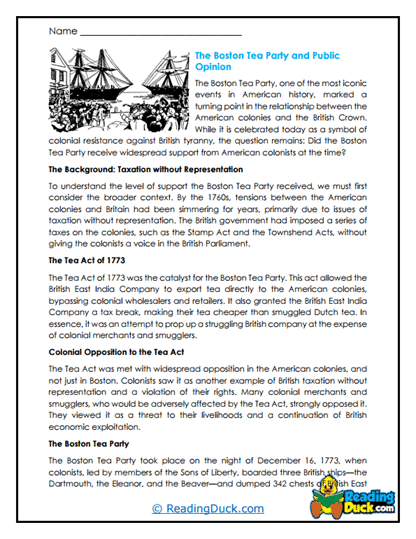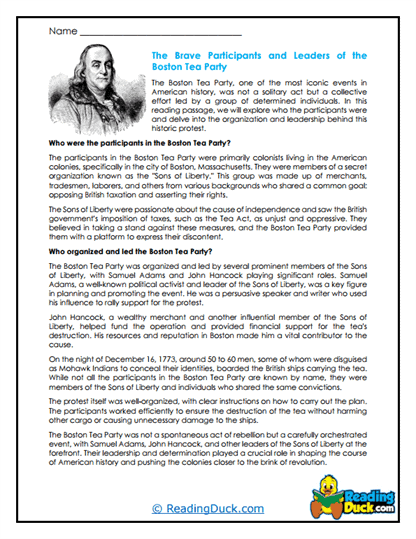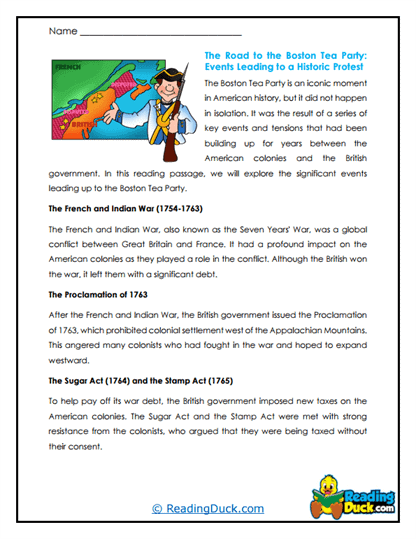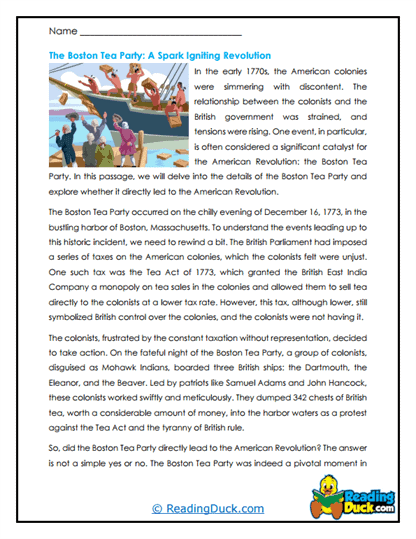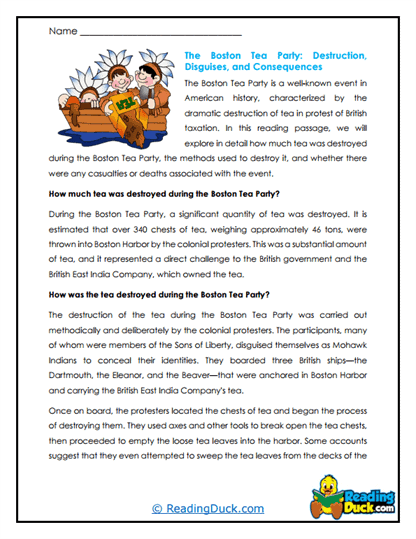Boston Tea Party Worksheets
About Our Boston Tea Party Worksheets
Our Boston Tea Party Worksheets are designed to engage students with one of the most significant events leading up to the American Revolution. The Boston Tea Party was a pivotal moment in U.S. history, showcasing the colonists' resistance to British policies and sparking the movement toward independence. Through this collection, students will delve into the details of the event, understand its causes and consequences, and connect with the historical significance of this act of defiance.
Each topic in this collection includes several worksheet sets, each thoughtfully designed to enhance students' learning experience:
- Multiple Choice Questions: These questions assess students' comprehension of the reading passages, helping them to grasp the key facts and concepts related to the Boston Tea Party.
- Short Answer Questions: Students are encouraged to express their understanding in their own words, which reinforces their learning and critical thinking abilities.
- Open-Ended Questions: These questions allow students to explore their personal opinions and reflections on the Boston Tea Party, fostering a deeper connection to the historical event and its relevance today.
An answer key is provided for every question sheet, making it easy for educators to evaluate students' understanding. All worksheets are available as PDF files, which can be easily viewed electronically, downloaded, and printed for use in various educational settings.
The Boston Tea Party: A Defining Act of Rebellion
The Boston Tea Party, which took place on December 16, 1773, was a significant event in American history that exemplified the growing tension between the American colonists and the British government. At its core, the Boston Tea Party was a protest against the Tea Act, a law that allowed the British East India Company to sell tea directly to the colonies, effectively bypassing colonial merchants and imposing taxes without colonial representation in Parliament. This act of defiance was a catalyst for the American Revolution and a symbol of the colonists' determination to fight for their rights.
Key Aspects of the Boston Tea Party:
- Causes of the Boston Tea Party: The event was rooted in the broader discontent with British taxation policies, particularly the Tea Act of 1773. The slogan "No taxation without representation" captured the colonists' frustration with being taxed by a government in which they had no political voice. Students can explore how the Tea Act was perceived as the final straw in a series of unpopular taxes, leading to widespread unrest in the colonies.
- The Event Itself: On the night of December 16, 1773, a group of colonists, disguised as Mohawk Indians, boarded three British ships—the Dartmouth, the Eleanor, and the Beaver—in Boston Harbor. They proceeded to dump 342 chests of tea into the harbor, an act that destroyed nearly 92,000 pounds of tea. This bold act of rebellion was both a statement against British authority and a demonstration of the colonists' willingness to take drastic measures to defend their rights. Students can examine the details of the event, the participants involved, and the immediate reactions from both the British government and the colonists.
- Consequences of the Boston Tea Party: The British government responded swiftly and harshly to the Boston Tea Party with the Coercive Acts, also known as the Intolerable Acts. These laws were designed to punish the colonies, particularly Massachusetts, by closing Boston Harbor, reducing colonial self-government, and allowing British soldiers to be quartered in private homes. These actions further inflamed tensions and unified the colonies in their opposition to British rule. Students can discuss how the Boston Tea Party and its aftermath set the stage for the First Continental Congress and the eventual outbreak of the American Revolutionary War.
The Significance of the Boston Tea Party in U.S. History
1. A Symbol of Resistance:
- Defiance Against Tyranny: The Boston Tea Party became a powerful symbol of resistance against British tyranny. It showed that the colonists were no longer willing to accept oppressive laws and taxes imposed by a distant government. This act of rebellion inspired similar protests across the colonies and galvanized the movement for independence.
- Unity Among the Colonies: The Boston Tea Party helped to unify the American colonies in their fight against British rule. The harsh response from the British government, including the implementation of the Intolerable Acts, prompted the colonies to come together to form the First Continental Congress, a significant step toward independence.
2. The Road to Revolution:
- Escalation of Conflict: The Boston Tea Party was a turning point that escalated the conflict between the colonies and Great Britain. It directly led to the outbreak of the American Revolutionary War, as the colonies realized that peaceful protest would not be enough to achieve their goals. Students can explore how the Boston Tea Party was one of the final steps before open conflict began.
- Inspiring Future Movements: The principles of liberty and resistance to tyranny demonstrated by the Boston Tea Party have continued to inspire movements for freedom and justice throughout American history. Students can discuss how this event has been referenced in various social and political movements, from the abolition of slavery to the civil rights movement.
3. The Power of Protest:
- Civil Disobedience: The Boston Tea Party is one of the earliest examples of civil disobedience in American history. It showed that ordinary citizens could take collective action to oppose unjust laws and that such actions could have significant political consequences. Students can examine the role of civil disobedience in the Boston Tea Party and compare it to other instances of protest in history.
- Legacy of the Boston Tea Party: The legacy of the Boston Tea Party continues to be felt today. It is commemorated annually in Boston, and its message of standing up against oppression remains relevant in contemporary discussions about government power, individual rights, and the importance of civic engagement.
Using These Worksheets in Social Studies Classes and Beyond
These Boston Tea Party worksheets can be used in a variety of educational settings, offering flexibility and creativity in how they are incorporated into lessons. Here are some tips for effectively using these worksheets in different contexts:
- Social Studies Classes:
- Historical Analysis: Use the worksheets to guide students through a detailed analysis of the Boston Tea Party, focusing on the causes, events, and consequences. Students can work in groups to research different aspects of the event and present their findings to the class.
- Timeline Creation: Have students create a timeline of events leading up to and following the Boston Tea Party. This activity can help them understand the sequence of events and how each action contributed to the growing tension between the colonies and Great Britain.
- Language Arts Integration:
- Persuasive Writing: Encourage students to write a persuasive essay from the perspective of a colonist or a British official. They can use the information from the worksheets to support their arguments, practicing their skills in persuasive writing and historical analysis.
- Creative Storytelling: Ask students to write a short story or a diary entry from the perspective of someone who participated in or witnessed the Boston Tea Party. This activity allows them to engage with history creatively while demonstrating their understanding of the event.
- Art and Design Projects:
- Poster Creation: Students can design posters that capture the spirit of the Boston Tea Party, using imagery and slogans that reflect the themes of resistance and unity. This activity can be a fun and creative way to reinforce their learning.
- Reenactment: Organize a reenactment of the Boston Tea Party in class, where students can dress up as historical figures and act out the events. This interactive approach can help bring history to life and make the learning experience more engaging.
- Cross-Curricular Connections:
- Civics and Government: Connect the Boston Tea Party to lessons on civics and government by discussing the role of protest in a democracy. Students can compare the Boston Tea Party to other historical and modern examples of protest, exploring the impact of citizen action on government policy.
- Economics: Explore the economic aspects of the Boston Tea Party by discussing the impact of British taxes on the colonial economy. Students can analyze how economic pressures contributed to the growing unrest and how the Tea Act affected colonial merchants.
By integrating these Boston Tea Party worksheets into various subjects and activities, educators can provide students with a well-rounded understanding of this pivotal event in U.S. history. These worksheets offer a versatile and engaging resource that helps students connect historical concepts to broader themes, fostering a deeper appreciation for the complexities of the American Revolution and the foundations of the United States.
